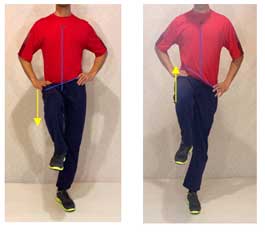Help if Your Back Becomes Stiff Every Morning
Sherwin Nicholson | Update May 6, 2020
What You Should Be Doing For Morning Stiffness
Stiffness is not only from aging but also from the habits you have developed
Two of the most common questions I get asked, is “Why does my back hurt so much in the morning?” and “What can I do so it doesn’t hurt anymore?”
It’s a very common question but there is a real solution to it. It involves beginning with this simple exercise taught below that you should do everyday.
Maintain your hip flexibility and you will win half the battle
Most people are reluctant to exercise in order to reduce their stiffness. You don’t need to be. The type that I recommend and perform myself everyday will keep your hips very well conditioned and will help to minimize your pain.
Over time, with age, lack of conditioning and injury, we become prone to waking up with stiffness. We are no longer able to naturally maintain the level of flexibility as we did as when we were younger.
Sometimes, our muscles are not able to recover fully from our busy schedule the night before.
That’s why Hip Shifting is crucial.
If you keep performing this ‘hip shift’ method to keep your hips mobile, they won’t tighten up overnight. It’s when they get tighter as you sleep that causes a lot of your discomfort.
Not only will your muscles remain tight overnight, your muscle conditioning and tone weakens also. Injury, inflammation and nerve pain also causes us to avoid certain movements in favor to avoid discomfort. By avoiding, you’ll keep the muscles tense overnight. In most situations you’re not even sure what the cause is.
Morning Stiffness
Morning back pain is misunderstood as a condition that is only present at that time. It is rather an ongoing problem that is simply more evident whenever you wake up. Read here for Misunderstandings With Morning Lumbar Pain.
The standing hip shift exercise can be performed to help you have the relief you’re looking for.
We benefit from exercise as it strengthens, stretches and provides much-needed flexibility to our lower back, hips, and legs vital for relief. Without such proper conditioning, these muscles continue to become less fit, thereby causing the lumbar spine to become prone to lack of support, risking injury.
The resulting injury and pain, in turn, can keep you from performing any exercise for relief. When you avoid exercising, a harmful cycle can happen where the damage leads to re-injury.
The Standing Hip Shift Exercise
Illustration below
This movement is rarely taught, yet we often perform a variation of it every day during our everyday routine (putting on your socks).
If it hurts, dressing and putting on your socks is not easy to do first thing in the day. You have developed significant stiffness in your hips so that it remains with you overnight. Although you may become more flexible towards the end of the day, your weaker hip muscles continue to make you prone to becoming very stiff.
The exercise targets weaker, tighter and often neglected lumbar region, hip and leg muscles. It is to be done with upright support and requires practice as balance, and hip shifting is encouraged.
Muscles Targeted:
- Rectus Abdominus
- Internal and External Obliques
- Transverse Abdominus
- Gluteals
- Tensor Fasciae Latae
- Piriformis
- Iliacus
- Iliopsoas
- Calves
- Vastus Medialis
- Rectus Femoris
The Stretch for Morning Stiffness
Standing Hip Shift
The should be a very obvious drop and raise of your hip as you hip shift. Dropping is easy but raising is what matters the most for overcoming the discomfort.
- Get the tips for your overnight pain
- How you can get a better night sleep
- Get the Ultimate Guide for your relief here!
- Is your job worsening your morning stiffness? Get help here.
References:
- Individual and intervention-related factors associated with adherence to home exercise in chronic lbp: a systematic review. – Beinart NA(1), Goodchild CE, Weinman JA, Ayis S, Godfrey EL. 1. Spine J. 2013 Dec;13(12):1940-50. doi: 10.1016/j.spinee.2013.08.027. Epub 2013Oct 26.
- Back-Pain – The Facts – John Lee, Clare Daniel, Suzanne Brook. NY. Oxford University Press – 2009. 617.564Lee
- www.nih.gov (The National Institutes of Health)
- www.mayoclinic.com
“I can feel that my back is beginning to become less tight. It feels more open and my muscles don’t feel as if they are always clenched.”
“I have chronic pain in my lower back and found your Mobility and Progressive exercises really helpful – my stiffness has decreased significantly – THANKS SO MUCH”



